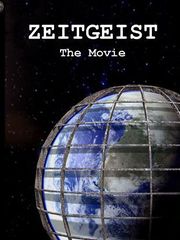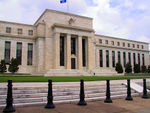Zeitgeist: the Movie
| Zeitgeist: the Movie | |
|---|---|
 |
|
| Directed by | Peter Joseph |
| Produced by | Peter Joseph[1] |
| Written by | Peter Joseph |
| Music by | Peter Joseph |
| Editing by | Peter Joseph |
| Distributed by | GMP LLC[2] |
| Release date(s) | 2007 |
| Running time | 122 min |
| Language | English |
| Followed by | Zeitgeist: Addendum |
Zeitgeist: the Movie is a 2007 documentary film by Peter Joseph that asserts a number of ideas, including an artificial, mythological origin of Christianity, alternate theories for the parties responsible for the destruction of the World Trade Center, and finally, claims that a cabal of international bankers are manipulating the international monetary system in order to introduce a unified world government. The film was officially released online on June 18, 2007 on zeitgeistmovie.com.[3] A sequel, Zeitgeist: Addendum, focuses further on the monetary system and advocates a resource-based social system influenced by the ideas of Jacque Fresco and The Venus Project.[4] Following Zeitgeist: Addendum, Peter Joseph created an organization called The Zeitgeist Movement to promote the ideas of Fresco's Venus Project.[5] Peter Joseph has publicly stated that The Zeitgeist Movement, while inspired by his film's content, is not an organization which supports them directly.[6] A third film called Zeitgeist: Moving Forward is scheduled to be released in Fall 2010. Peter Joseph has stated that its topics will focus on human behavior, technology, and rationality.[7]
Contents |
Synopsis
The film opens with animated abstract visualizations, film and stock footage, a cartoon and audio quotes. The latter include part of a speech by Chögyam Trungpa Rinpoché about spirituality, followed by a series of musically synchronized clips of war and explosions culminating with the September 11 attacks. This is followed by a sequence of clips showing war casualties. The film's title screen is displayed, and Jordan Maxwell's Inner World of the Occult is quoted, which criticizes the honesty of religious institutions, governments, and banking cartels which are alleged to "have misled [the people] away from the true and divine presence in the universe." The film's introduction ends with a portion of the late comedian George Carlin's monologue on religion accompanied by an animated cartoon.
Part I
Part I, entitled The Greatest Story Ever Told, questions religions as being god-given stories, arguing that the Christian religion specifically is mainly derived from other religions, astronomical facts, astrological myths and traditions, which in turn were derived from or shared elements with others. In furtherance of the Jesus myth hypothesis, this part argues that the historical Jesus is a literary and astrological hybrid, nurtured politically.
This section was based on a variety of writers and film makers, including the 19th century poet and amateur Egyptologist Gerald Massey, the mythologist Joseph Campbell and D.M Murdock (Acharya S).[8][9] Horus, an ancient Egyptian god of sky, war, or protection (referred to in the movie as a 'sun god),' is introduced as having a number of attributes similar to that of many of the religious deities which came after him, including but not limited to Attis, Krishna, Dionysus, Mithra and Jesus Christ; the attributes imputed to him include a virgin birth on December 25, twelve disciples, burial for three days, resurrection, and the performing of miracles.[10][11][12][13]
The film expounds upon its claims about attributes in common. To explain the origin of the common December 25 birth, the film shows that at the winter solstice, December 22, the shortest day of the year with the shortest hours of sunlight (in the northern hemisphere), sunset is in the vicinity of Crux with Jesus' death on the cross being based on a similar principle. For three days, the change in the time of the sunrise is imperceptible. Then, on December 25, the hours of sunlight can be seen to be increasing, marking the birth of a "god of light" or sun god. Another Christian-astrological similarity, according to the film, is that the three stars in Orion's belt (called the "Three Kings") align on December 25 with Sirius, the brightest star in the sky, and point to the Sun's rise on the horizon. This time is equated to the nativity of Jesus, where, according to the popular Christian belief, three "kings" follow the star in the east to locate the place of Jesus' birth. In addition, parallels such as walking on water (reflection at dawn/dusk), helping the blind see (without light there's nothing, black; with light, one can see again) and turning water into wine (ripening of grapes) are shown as metaphoric miracles, explained as the influence of the Sun. According to egyptologists, however, Horus' birth was on the second Epagomenal day (early august).[14]
The film then presents the names of 23 writers from the 1st century CE (such as Petronius and Pomponius Mela) who do not mention Christ. According to the Zeitgeist, The Movie transcript, this list comes from both D. M. Murdock's book, Who Was Jesus?[15] and a version of Remsburg's 1909 The Christ that had been retitled The Christ Myth.[16][17] The narrator then disputes the authenticity of Tacitus, Pliny the Younger, Suetonius and Josephus' references to Christ. The film argues against the existence of a historical Christ.
Christianity is thereby argued to be a Gnostic myth, historicized by the Roman Empire for social control of Europe through doctrines established at the First Council of Nicea. The Dark Ages, the Inquisitions and the Crusades are presented as events which maintained Europe's submission to The Vatican through Christianity. The following is said in conclusion: "Christianity, along with all other theistic belief systems [...] empowers those who know the truth, but use the myth to manipulate and control societies. [...] It reduces human responsibility to the effect that "God" controls everything, and in turn awful crimes can be justified in the name of Divine Pursuit. [...] The religious myth is the most powerful device ever created, and serves as the psychological soil upon which other myths can flourish."
Part II

Part II, entitled All the World's a Stage, uses integral footage of several 9/11 conspiracy theory films to illustrate how the September 11 attacks were either orchestrated or allowed to happen by elements within the United States government in order to generate mass fear, initiate and justify the War on Terror, provide a pretext for the curtailment of civil liberties, and produce economic gain. These claims include that the US government had advance knowledge about the attacks, the response of the military deliberately let the planes reach their targets, and the World Trade Center buildings 1, 2, and 7 underwent a controlled demolition. The film claims that six of the named hijackers are still alive, that Hani Hanjour could not have flown Flight 77 into the Pentagon, that no substantial plane wreckage was found at two of the three crash sites, that the Bush administration covered up the truth in the 9/11 Commission Report, and that the mainstream media have failed to ask important questions about the official account.
However, in a March 17, 2009 article, the New York Times, after noting that the first Zeitgeist film "may be most famous for alleging that the attacks of September 11 were an 'inside job' perpetrated by a power-hungry government on its witless population," goes on to say that this is a point of view that Mr. Joseph said he has recently "moved away from."[18] Peter Joseph later clarified this statement as a "misquote" on his movement's website forum and continues his support for a new 9/11 investigation.[19]
Part III

Part III, entitled Don't Mind the Men Behind the Curtain, argues that three wars of the United States during the twentieth century were waged purely for economic gain by what the film refers to as "international bankers". The film alleges that certain events were engineered or were allowed to happen as excuses to enter into war including the sinking of the RMS Lusitania (a factor in the US decision to enter World War I two years later), the Attack on Pearl Harbor (which was the opening attack of the Japanese on the US in World War II), and the Gulf of Tonkin Incident (which led to the escalation of the Vietnam War).
According to the film, the US was forced by the Federal Reserve Bank to become embroiled in these wars, not with a view to win but to sustain the conflict, as this forces the US government to borrow money from the bank, allegedly increasing the profits of the "international bankers". The film gives a history of the Federal Reserve, claiming it engineered the Great Depression to steal wealth from the American people and was responsible for the assassination of Louis McFadden, a congressman who attempted to impeach the Federal Reserve Board. The film then goes on to claim that the Federal Income Tax is illegal.
This section also claims the existence of a secret agreement to merge the United States, Canada and Mexico into a "North American Union" and to replace the Canadian dollar, United States dollar, and the Mexican peso with a new currency, called the "amero". The creation of this North American Union is then alleged to be a step towards the creation of "One World Government", which would be formed by the merging of the North American Union, the European Union, the African Union and a hypothetical Asian Union. The film speculates that under such a government, every human could be implanted with an RFID chip that would be used to monitor individuals and suppress dissent. The film ends with several quotes from Carl Sagan, Bill Hicks, George Carlin and others.
An updated version of Zeitgeist released in 2010 removes the North American Union section among other changes.[20]
Awards
The film was screened on November 10, 2007 at the Egyptian Theater in Hollywood as part of a film festival held there (the 4th Annual Artivist Film Festival) where it won the Best Feature award in the Artivist Spirit category for feature-length documentaries.[21][22] In 2008, "Zeitgeist: Addendum", the sequel, received the same Artivist Spirit award at the Egyptian Theater in Hollywood.[23] In September 2008, Zeitgeist, The Movie also received a Special Acknowledgment Award at Rutger Hauer's ICFILMS Film Festival in Milan, Italy.[24]
Critics
A review in The Irish Times entitled “Zeitgeist: the Nonsense” wrote that “these are surreal perversions of genuine issues and debates, and they tarnish all criticism of faith, the Bush administration and globalization—there are more than enough factual injustices in this world to be going around without having to invent fictional ones."[25] Skeptic magazine's Tim Callahan criticizes the first part of the film on the origins of Christianity:
Some of what it asserts is true. Unfortunately, this material is liberally—and sloppily—mixed with material that is only partially true and much that is plainly and simply bogus. […] Zeitgeist is The Da Vinci Code on steroids.[26]
Other reviews assert that it is "conspiracy crap",[27] “based solely on anecdotal evidence” and “fiction couched in a few facts”,[28] or disparaging reference is made to its part in "the 9/11 truth movement".[18]
Academic coverage of Zeitgeist has also been sparse, mainly lumping the movie in with other conspiracy movies, and typically treating it as part of a contemporary phenomenon of “truth” movies. According to an article published in Scientific American by Michael Shermer:
“The postmodernist belief in the relativism of truth, coupled to the clicker culture of mass media where attention spans are measured in New York minutes, leaves us with a bewildering array of truth claims packaged in infotainment units. It must be true—I saw it on television, at the movies, on the Internet, The Twilight Zone, The Outer Limits, That's Incredible, The Sixth Sense, Poltergeist, Loose Change, Zeitgeist the Movie.”[29]
A more severe overall treatment is given by Jane Chapman, a film producer and reader in media studies at the University of Lincoln, who analyzes Zeitgeist (“A fast-paced assemblage of agitprop”) as an example of unethical film-making.[30] She accuses Joseph of deceit through the use of unsourced and unreferenced assertions, and standard film-making propaganda techniques. While parts of the film are, she says, “comically” self-defeating, the nature of “twisted evidence” and the false attribution of Madrid bomb footage as being in London (which she calls a “lie”) amount to ethical abuse in sourcing (in later versions of the movie, a subtitle is added to this footage identifying it as from the Madrid bombings). She finishes her analysis with the comment:
Thus legitimate questions about what happened on 9/11, and about corruption in religious and financial organizations, are all undermined by the film’s determined effort to maximize an emotional response at the expense of reasoned argument.
Chris Forbes, Senior lecturer in Ancient History of Macquarie University and member of the Synod of the Diocese of Sydney, has severely criticized Part I of the movie as having no basis in serious scholarship or ancient sources, relying on amateur sources that "borrow ideas from each other, and who recycle the same silly stuff" and "not a single serious source" can be found in official reference lists attached to the movie.[31] Of the film he says "It is extraordinary how many claims it makes which are simply not true."[31]
Forbes claims there is no evidence in Egyptian sources saying that Horus' mother Isis was a virgin. Similarly, neither Krishna (the eighth son), Dionysus (whose mother had slept with Zeus) nor Attis were ever supposed born of virgins. He points out that "son" and "sun" are not homophonic words in either Latin, Ancient Egyptian, or Greek, and therefore no such misunderstanding would occur; that the December 25 birth is not part of any of the myths, including that of Jesus, for whom Christmas Day was appointed as a festival day in open knowledge that the real date was not known (December 25 was actually the day when the god Mithras was born out of a stone).[32]
Forbes also criticizes the movie's use of Roman sources to suggest that Jesus didn't exist, noting that a long list flashed across the screen of supposed contemporaneous historians that did not mention Jesus is actually a list of geographers, gardening writers, poets and philosophers, who should not be expected to mention him. The allegation that Josephus' mention of Jesus was added later is criticized as misleading. Josephus actually mentions Jesus twice, with only one reference believed by scholars to have been doctored in the Middle Ages but to change an already existing mention of him. He also argues that the film misrepresents Constantine when it presents him as making Christianity compulsory, when he only legalized it (it was Theodosius I who made it compulsory later in the 4th century) and inventing the historical Jesus, when early records show that the historicity of Jesus had been a key element of faith from early on.
Zeitgeist: Addendum
| Zeitgeist Addendum | |
|---|---|
| Directed by | Peter Joseph |
| Produced by | Peter Joseph[33] |
| Written by | Peter Joseph |
| Music by | Peter Joseph |
| Editing by | Peter Joseph |
| Distributed by | GMP LLC[34] |
| Release date(s) | 2008 |
| Running time | 123 min |
| Language | English |
| Preceded by | Zeitgeist, The Movie |
| Followed by | Zeitgeist: Moving Forward |
Zeitgeist: Addendum premiered at the 5th Annual Artivist Film Festival in Los Angeles, California on October 2, 2008, winning their highest award. It was released free online on October 4, 2008.[35] Director Peter Joseph stated: "The failure of our world to resolve the issues of war, poverty, and corruption, rests within a gross ignorance about what guides human behavior to begin with. It addresses the true source of the instability in our society, while offering the only fundamental, long-term solution."[23]
Part I follows on from Part III from the original film, citing the specific process of fractional-reserve banking as detailed in Modern Money Mechanics, released by the Federal Reserve Bank of Chicago. In detailing the process of so-called money creation in banks, the film suggests that society is manipulated into economic slavery through debt-based monetary policies by requiring individuals to submit for employment in order to pay off their debt.
Part II is a documentary-style interview with The New York Times best-selling author and activist John Perkins based on his book, Confessions of an Economic Hit Man, in which he outlines his role as a self-described Economic Hit Man. In that capacity, he claims to have helped the CIA, as well as various corporate and political entities, to undermine or corrupt foreign regimes that put the interests of their populations before those of transnational corporations. Perkins denies the existence of a conspiracy, because he sees the US as a corporatocracy, in which there is no need for a plot, as politicians like Dick Cheney—who first was a self-professed "public servant" congressman, Secretary of Defense then served as the head of a construction company Halliburton before becoming Vice President—are alleged to be working under the same primary assumption as corporations: that maximization of profits is first priority, regardless of any social or environmental cost.
Part III is a documentary-style interview with futurist Jacque Fresco. The film looks at Fresco's proposal of a "resource-based economy", which he states would create abundance, is environmentally friendly and sustainable. He goes on to discuss technology which he sees as the primary driver of human advancement and he blames politics as being unable to solve any problems, because of a lack of "technical capabilities". Fresco states that his approach is not perfect, but that "it's just much better than what we have. We can never achieve perfection".
Part IV of the film suggests that the primary reason for what it sees as society's social values ("warfare, corruption, oppressive laws, social stratification, irrelevant superstitions, environmental destruction, and a despotic, socially indifferent, profit oriented, ruling class") is a collective ignorance of "the emergent and symbiotic aspects of natural law." The film suggests several actions for "social change", which include: boycotting banks who are claimed to make up the Federal Reserve System, such as JPMorgan Chase, Bank Of America and Citibank, turning off TV news, not joining the military, refusing energy from energy companies in favor of making homes self-sustainable with clean energy, and rejecting the political structure. It also implores viewers to join The Zeitgeist Movement by visiting the movement's official website. The film closes by asking everyone to "eliminate the divisionary, materialistic noise, we have been conditioned to think is true ... while discovering, amplifying and aligning with the signal coming from our true, empirical oneness."
Zeitgeist: Moving Forward
| Zeitgeist: Moving Forward | |
|---|---|
| Directed by | Peter Joseph |
| Produced by | Peter Joseph[33] |
| Written by | Peter Joseph |
| Music by | Peter Joseph |
| Editing by | Peter Joseph |
| Release date(s) | December 2010 (Target) |
| Running time | 3hrs approx. |
| Language | English |
| Preceded by | Zeitgeist: Addendum |
Zeitgeist: Moving Forward is the next film by Peter Joseph in the Zeitgeist, The Movie series. The release date was originally announced for October 2010, but a new update by Peter Joseph on August 12, 2010 indicates the goal is now by the end of 2010.[36] Technically the film is, as stated by Peter, "far more complex [than addendum], [has] far more dramatic elements, far more difficult animations that I had to hire a tremendous number of people to take out both in 3D and 2D, [and] a lot of hand-drawn [sequences].[36] The content of the film is still not fully revealed. Peter has mentioned the opening scene is an extended opening with Jacque Fresco.[36] He has also stated that its "topics will focus on human behavior, technology, and rationality".
See also
- The Zeitgeist Movement
- Bible conspiracy theory
- Christ myth theory
- Jesus Christ in comparative mythology
- 9/11 conspiracy theories
- Money as Debt
References
- ↑ "IMDb Profile". imdb.com. February 18, 2008. http://www.imdb.com/title/tt1166827/. Retrieved March 15, 2009.
- ↑ "IMDb company credits". imdb.com. http://www.imdb.com/title/tt1166827/companycredits. Retrieved March 15, 2009.
- ↑ Ananda, Rady. "Zeitgeist Addendum: Steps toward a sustainable future". OpEdNews. http://www.opednews.com/articles/Zeitgeist-Addendum-Steps-by-Rady-Ananda-081012-334.html. Retrieved 23 July 2009.
- ↑ "Statement". Zeitgeistmovie.com. http://www.zeitgeistmovie.com/statement.htm. Retrieved 23 July 2009.
- ↑ Joseph, Peter; Roxanne Meadows, Jacque Fresco (February 2009). "Movement Orientation Guide:THE ZEITGEIST MOVEMENT – OBSERVATIONS AND RESPONSES". Activist Orientation Guide. www.thezeitgeistmovement.com. http://www.thezeitgeistmovement.com/The%20Zeitgeist%20Movement.pdf. Retrieved 2009-04-08.
- ↑ http://www.thezeitgeistmovement.com/joomla/index.php?option=com_kb&task=article&article=3&Itemid=100091
- ↑ The Zeitgeist Movement Public Forum, Radio Address, Full Q & As (from Peter), available at http://www.thezeitgeistmovement.com/joomla/index.php?option=com_kunena&Itemid=1905&func=showcat&catid=232. Retrieved on 2009-05-31
- ↑ "Zeitgeist, the Movie Credits". Zeitgeistmovie.com. http://www.zeitgeistmovie.com/sources.htm. Retrieved 23 July 2009.
- ↑ "ZEITGEIST Companion Guide Ebook / Part 1 / Horus / Jesus". Stellar House Publishing. http://www.stellarhousepublishing.com/zeitgeist.html. Retrieved 23 July 2009.
- ↑ "Zeitgeist, The Movie Transcript". Zeitgeistmovie.com. http://www.zeitgeistmovie.com/transcript.htm. Retrieved 23 July 2009.
- ↑ "Jordan Maxwell – The Naked Truth Part 1". The International Research and Education Society. http://www.youtube.com/watch?v=qJqivq4BzcU&feature=PlayList&p=8E76B3CDF30704C4&playnext=1&playnext_from=PL&index=25. Retrieved 2 October 2009.
- ↑ http://www.youtube.com/watch?v=wYRtWFwmoy0
- ↑ http://www.zeitgeistmovie.com/sources.htm
- ↑ http://www.philae.nu/akhet/Calendar.html
- ↑ Murdock, D. M. (2007). 'Who Was Jesus?. Stellar Hourse. p. 85. ISBN 0-9799631-0-9.
- ↑ Remsburg, John E.(1909) The Christ Chapter 2—Silence of Contemporary Writers
- ↑ Zeitgeist, The Movie transcript
- ↑ 18.0 18.1 Feuer, Alan (March 17, 2009). "They’ve Seen the Future and Dislike the Present". The New York Times: p. A24. http://www.nytimes.com/2009/03/17/nyregion/17zeitgeist.html.
- ↑ "NEW YORK TIMES REVIEW: 9/11 MISQUOTE". TheZeitgeistMovement.com. http://www.thezeitgeistmovement.com/joomla/index.php?option=com_kunena&Itemid=1905&func=view&catid=229&id=85094. Retrieved 23 July 2009.
- ↑ Zeitgeist The Movie (2010 version)
- ↑ "4th Annual Artivist Film Festival and Artivist Awards Announce the Winning Films of This Year's Festival". Artivist Film Festival and Artivist Award press release. November 5, 2007. http://www.marketwire.com/mw/release.do?id=788818. Retrieved February 10, 2009.
- ↑ "4th Annual Artivist Film Festival & Artivist Awards: "Merging Art & Activism"". Artivist Film Festival and Artivist Awards press release. October 31, 2007. http://newsblaze.com/story/20071031143153tsop.np/topstory.html. Retrieved February 10, 2009.
- ↑ 23.0 23.1 Artivist Film Festival website
- ↑ "The 2008 Winners". I've Seen Films International Film Festival. http://www.cortoweb.com/icfilms/eng/winners.php.
- ↑ "Zeitgeist: the nonsense". The Irish Times. 25 August 2008. http://www.irishtimes.com/newspaper/weekend/2007/0825/1187332519087.html.
- ↑ Callahan, Tim (2009). "The Greatest Story Ever Garbled". Skeptic 28 (1). http://www.skeptic.com/eskeptic/09-02-25#feature.
- ↑ Orange, Michelle (10 September 2008). "Able Danger". The Village Voice. http://www.villagevoice.com/2008-09-10/film/able-danger/.
- ↑ "Towers of Babble". Utne Reader. January 1, 2008. http://www.utne.com/2008-01-01/Politics/Towers-of-Babble.aspx.
- ↑ Shermer, Michael (July 2009). "I Want to Believe". Scientific American. http://www.scientificamerican.com/article.cfm?id=what-skepticism-reveals.
- ↑ Chapman, Jane (2009). Documentary in Practice: Filmmakers and Production Choices. Polity Press. pp. 171–173. ISBN 978-0745636122.
- ↑ 31.0 31.1 "Zeitgeist: Time to discard the Christian story?". Interview at the Centre for Public Christianity, Sydney, Australia. http://www.publicchristianity.com/Videos/zeitgeist.html.
- ↑ http://ancienthistory.about.com/od/holidaysfestivals/a/solsticeceleb_4.htm
- ↑ 33.0 33.1 "IMDb Profile". imdb.com. http://www.imdb.com/title/tt1332128/. Retrieved March 15, 2009.
- ↑ "IMDb company credits". imdb.com. http://www.imdb.com/title/tt1332128/companycredits. Retrieved March 15, 2009.
- ↑ The Wall Street Journal Digital Network's Market Watch , Press release.
- ↑ 36.0 36.1 36.2 Updates with Peter Joespeh (Part 2 of 6), Skype call on Aug. 12, 2010.
External links
- ZeitgeistMovie.com The Zeitgeist Film Series Gateway
- [1] Official Website for Zeitgeist: The Movie
- [2] Official Website for Zeitgeist: Addendum
- [3] Official 220 Page "Companion Source Guide" for Zeitgeist: The Movie (2010)
- Zeitgeist, The Movie (2010 updated version) at Vimeo
- Zeitgeist: Addendum at Vimeo
- Zeitgeist: Addendum at the Internet Movie Database
- Zeitgeist: The Movie at the Internet Movie Database
- Skeptic: The Greatest Story Ever Garbled by Tim Callahan
- Zeitgeist Debunked with guest Tim Callahan Reasonable Doubts podcast
- Interview with ancient historian Dr Chris Forbes at Centre for Public Christianity
|
||||||||||||||||||||
|
||||||||||||||||||||||||||||||||||||||||||||||||
|
||||||||||||||||||||||||||||||||||||||

